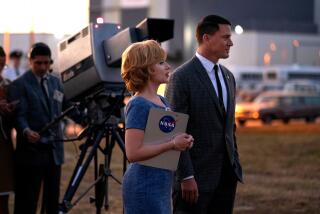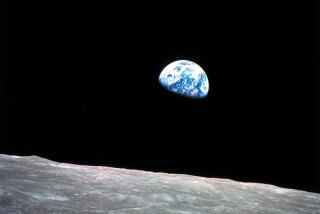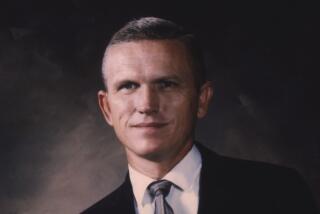The stakes were high: the moon
“Race to the Moon,” which airs tonight on PBS as part of “American Experience,” is the story of Apollo 8, the first manned orbit around the moon. Written and directed by Kevin Michael Kertscher, it is a splendid telling of an exciting tale, economical yet powerful and marred only by a corny, overemphatic score (which is loud in the mix, besides), all the more disappointing given how well everything else is done.
The film captures not only the sense of scientific adventure and political necessity that attended the mission but also its emotional, decidedly spiritual finishing note. It is also quite beautiful to behold -- mostly in sharp, vivid color that brings the past forcefully into the present.
The film puts you into a time when this was something no one had ever done before -- when space was still all possibility, and every step was new and romantic, rather than the practical, now almost prosaic shuttles and space stations that are only news when something goes wrong.
It’s been 33 years since any earthling has left Earth’s orbit; the world is now full of people, grown people, who were not alive the last time anyone stood on the surface of the moon. Just what that meant then is perhaps hard to grasp now, like much else about that time, and especially that troubled year of 1968, a year of riots and assassinations, escalation and protest. But “Race to the Moon” does as good a job as possible of getting it across.
Apollo 8, which launched on Dec. 21, 1968, and returned home two days after Christmas, was a rush job, a preemptory reimagining of its original mission to beat the Soviets, who were thought to be ready to send a man around the moon. It was also to make good on President John F. Kennedy’s 1962 vow to put an American on luna firma by the end of the decade.
Given the difficulties plaguing the Apollo program -- starting with the fire that killed the crew of Apollo 1 -- and the enormous number of first-time mechanical operations and maneuvers the mission entailed, it was a bold, almost reckless decision.
“Man perhaps on the way to the moon,” Walter Cronkite says as the rocket leaves the launch pad. The “perhaps” was accurate: When astronaut Frank Borman’s wife asked for a real estimation of her husband’s getting back alive, she was told “50-50.”
For everyone but the people involved, the Space Age was a TV event. It was a childhood rite on launch days to rise before dawn and count down with Uncle Cronkite -- who somehow remains the personification of the reported story.
For the first time, through the cameras that broadcast Earth’s picture back to its people, and from the even more astonishing shots of lunar earthrise the astronauts brought back with them, the planet was glimpsed whole -- not the political globe of borderlines and pastel patches and labels but a delicate totality of blue, white and green.
How could it be possible after that moment, Cronkite wonders here, for people to “live in enmity instead of an understanding of a brotherhood of all of us alone together ... in the universe.” But it was only a moment.
*
‘American Experience: Race to the Moon’
Where: KCET
When: 9 tonight
Ratings: TV-PG (may be unsuitable for young children)
Frank Borman...self
James Lovell...self
Bill Anders...self
Producer/director/writer: Kevin Michael Kertscher. Executive producer: Mark Samels.
More to Read
The complete guide to home viewing
Get Screen Gab for everything about the TV shows and streaming movies everyone’s talking about.
You may occasionally receive promotional content from the Los Angeles Times.







